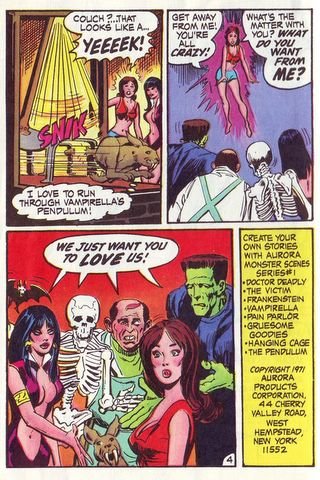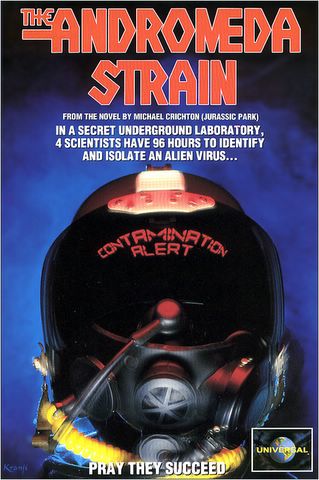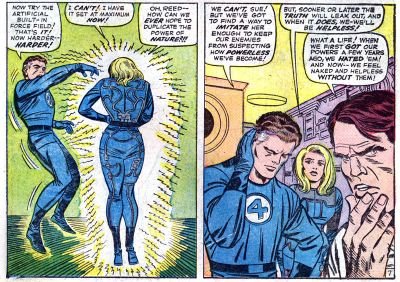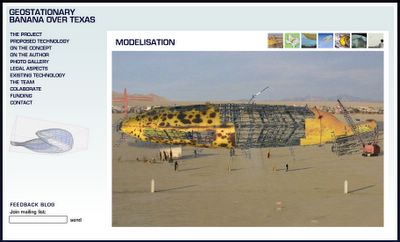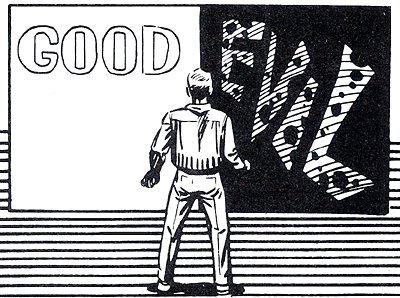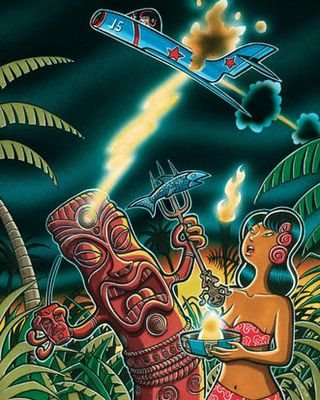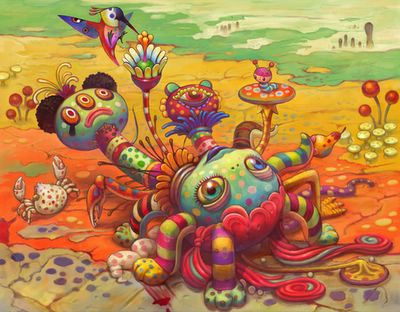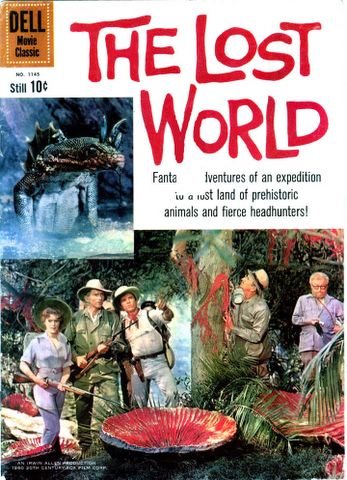 was applied for by Dr. John Harvey Kellogg. He was trying to improve the vegetarian diet of his hospital patients, by searching for a digestible bread-substitute by the process of boiling wheat. Kellogg accidentally left a pot of boiled wheat to stand and become tempered. When it was put through a rolling process, each grain of wheat emerged as a large, thin flake. When the flakes were baked, they became crisp and light, creating an easy to prepare breakfast when milk was added. Link Image Link
was applied for by Dr. John Harvey Kellogg. He was trying to improve the vegetarian diet of his hospital patients, by searching for a digestible bread-substitute by the process of boiling wheat. Kellogg accidentally left a pot of boiled wheat to stand and become tempered. When it was put through a rolling process, each grain of wheat emerged as a large, thin flake. When the flakes were baked, they became crisp and light, creating an easy to prepare breakfast when milk was added. Link Image LinkWednesday, May 31, 2006
Corn Flakes Invented This Day
 was applied for by Dr. John Harvey Kellogg. He was trying to improve the vegetarian diet of his hospital patients, by searching for a digestible bread-substitute by the process of boiling wheat. Kellogg accidentally left a pot of boiled wheat to stand and become tempered. When it was put through a rolling process, each grain of wheat emerged as a large, thin flake. When the flakes were baked, they became crisp and light, creating an easy to prepare breakfast when milk was added. Link Image Link
was applied for by Dr. John Harvey Kellogg. He was trying to improve the vegetarian diet of his hospital patients, by searching for a digestible bread-substitute by the process of boiling wheat. Kellogg accidentally left a pot of boiled wheat to stand and become tempered. When it was put through a rolling process, each grain of wheat emerged as a large, thin flake. When the flakes were baked, they became crisp and light, creating an easy to prepare breakfast when milk was added. Link Image LinkTuesday, May 30, 2006
Vampirella: Aurora Monster Scenes
Back in the early 70's Aurora produced a series of "Monster Scenes" model kits based around a Vampirella figure. These are the instructions for assembling one of the pieces featuring the art of either Neal Adams or his Continuity Studios. Note the ridiculous lengths the accompanying comic had to stretch to try to make it somehow 'wholesome' for kids (or at least the parents buying these things).
Monday, May 29, 2006
Bending Starlight Supports Relativity
The Drake Equation
Carl Sagan and Drake designed the plaques on Pioneer 10 and Pioneer 11 for the purpose of greeting and informing any extraterrestrial life that might find the vessels after they left the solar system. Link
Fireball XL5 Blasts Off!
Sunday, May 28, 2006
Alex Toth: 1928-2006
5th Dimensional 'Braneworld'

Charles R. Keeton of Rutgers and Arlie O. Petters of Duke base their work on a recent theory called the type II Randall-Sundrum braneworld gravity model. The theory holds that the visible universe is a membrane (hence "braneworld") embedded within a larger universe, much like a strand of filmy seaweed floating in the ocean. The "braneworld universe" has five dimensions -- four spatial dimensions plus time -- compared with the four dimensions -- three spatial, plus time -- laid out in the General Theory of Relativity.
The braneworld theory predicts that relatively small "black holes" created in the early universe have survived to the present. The black holes, with mass similar to a tiny asteroid, would be part of the "dark matter" in the universe. As the name suggests, dark matter does not emit or reflect light, but does exert a gravitational force.
"A good place to look for gravitational lensing by braneworld black holes is in bursts of gamma rays coming to Earth," Keeton said. These gamma-ray bursts are thought to be produced by enormous explosions throughout the universe. Such bursts from outer space were discovered inadvertently by the U.S. Air Force in the 1960s.
"If the braneworld theory is correct," they said, "there should be many, many more braneworld black holes throughout the universe, each carrying the signature of a fourth dimension of space."
Robot hand Controlled By Thought
The robotic hand mimics the movements of a person's real hand, based on real-time functional magnetic resonance imaging (fMRI) of their brain activity. It marks another landmark in the advance towards prosthetics and computers that can be operating by thought alone.
The system was developed by Yukiyasu Kamitani and colleagues from the ATR Computational Neuroscience Laboratories in Kyoto, and researchers from the Honda Research Institute in Saitama.
Subjects lay inside an MRI scanner and were asked to make "rock, paper, scissor" shapes with their right hand. As they did this, the MRI scanner recorded brain activity during the formation of each shape and fed this data to a connected computer. After a short training period, the computer was able to recognise the brain activity associated with each shape and command the robotic appendage do the same.
Friday, May 26, 2006
Leeuwenhoek Sees Animalcules
On this day in
 1676, Antonie van Leeuwenhoek applied his hobby of making microscopes from his own handmade lenses to observe some water running off a roof during a heavy rainstorm.
1676, Antonie van Leeuwenhoek applied his hobby of making microscopes from his own handmade lenses to observe some water running off a roof during a heavy rainstorm. He finds that it contains, in his words, "very little animalcules." The life he has found in the runoff water is not present in pure rainwater. This was a fundamental discovery, for it showed that the bacteria and one-celled animals did not fall from the sky. Link
Thursday, May 25, 2006
Invisible Man Almost Visible
He and John Pendry of Imperial College London, UK, and their co-workers have independently described similar ways to create an invisible 'hole' in space, inside which objects can be hidden. They say it is possible to guide light around the hole, rather like water flowing around a rock in a river, so that the object inside it cannot be seen.
Light rays are bent when they pass between materials with different refractive indices, such as air and water. But bending light so that it passes round a region of space and emerges travelling along the same line as it was initially is a difficult trick, requiring an invisibility cloak made from materials with a 'tunable' refractive index.
Such substances have been made, in the form of so-called metamaterials. These are built from rings or coils of metal wire, etched into printed circuit boards and glued together, which act as antennae that interact with the electromagnetic field of incoming light and modify the paths the light takes. Such metamaterials can have bizarre optical properties: for example, having negative refractive index, so that they bend light the 'wrong' way.
Wednesday, May 24, 2006
Dracorex hogwartsia
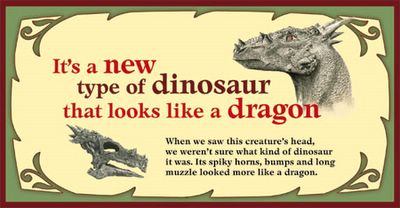 The name Dracorex hogwartsia, from the Latin words draco (meaning dragon), rex (meaning king), and hogwartsia (after the fictional Hogwarts School for Witchcraft and Wizardry created by J.K. Rowling).
The name Dracorex hogwartsia, from the Latin words draco (meaning dragon), rex (meaning king), and hogwartsia (after the fictional Hogwarts School for Witchcraft and Wizardry created by J.K. Rowling).The nearly complete skull was discovered by three friends; Steve Saulsbury, Patrick Saulsbury and Brian Buckmeier, all from Sioux City, Iowa. They found it during a fossil collecting trip in South Dakota and donated it to The Children’s Museum of Indianapolis. When it was brought to the museum’s Paleo Prep Lab for cleaning and studying, it was little more than a box of parts. It took two years to patiently glue together the many fragments and restore the skull.
Tuesday, May 23, 2006
Flesh-Eating Disease Explained
Neutron Star Ejects Matter at Speed of Light
Astrophysicists using NASA's Spitzer Space Telescope recently spotted one of these jets around a super-dense dead star, confirming for the first time that neutron stars as well as black holes can produce these fire-hose-like jets of matter.
As the smaller star travels around its dead partner, the neutron star's intense gravity picks up material leaving the smaller star’s atmosphere and creates a disk around itself. The disk of matter, or accretion disk, circles the neutron star similar to the way rings circle Saturn.
Monday, May 22, 2006
Trees - On The Shore

Link
Lp. CBS 64168 / Lp. Decal LIK 12 (1987) / Cd. Beat Goes On BGOCD 173 (1993) / Cd. Columbia 484435 (1996)
Bias Boshell/guitar, vocals; Unwin Brown/drums, vocals; Barry Clark/guitar; David Costa/guitar; Tony Cox/bass; Celia Humphris/keyboards, vocals; Michael Jeffries/harp
Released in 1970, this record soon disappeared and became a sought-after classic. This folk-rock outfit influenced by Fairport Convention only bought out two albums before they split up and this is their debut. Tobias Boshell, the main songwriter then joined Kiki Dee's Band and wrote her biggest hit, "I've Got the Music in Me".
I’ve never heard the album but I’ve always liked the cover (by Hipnosis if I remember correctly).
It’s this week’s featured album on the Freak Zone on BBC 6 Radio. You can listen to the entire show by clicking HERE.
Geostationary Banana Over Texas Project
Father of "Antigravity" Born This Day
Sturgeon also worked on improving the voltaic battery, developing a theory of thermoelectricity, and even atmospheric charge conditions. From 500 kite flights made in calm weather, he found the atmosphere is consistently charged positively with respect to the Earth, and increasingly so at increased height. Link
Sunday, May 21, 2006
Tom Bagley Talks Albertan Dinos
Tom's a great artist (see above) and is closely associated with the spooky Calgary band, "Forbidden Dimension." Spin some records on the FD jukebox HERE.
Both Tom and Kipling contribute to the excellent blog, 7 DEADLY SINNERS. Go check it out!
Lobster Johnson Vs. The Red Skull
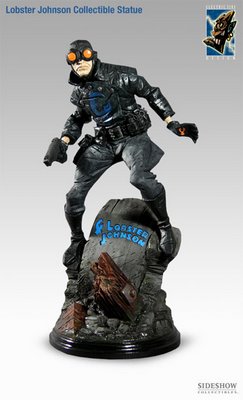

Lobster Johnson statue from the Imperial War Museum, London; Photo of the Red Skull statue in Berlin (destroyed at the end of the war) from the National Archives, London.

Panel from the classic story,"Red Skull's Deadly Revenge", Lobster Johnson #16 (No. 1940).
“The Time: Now. The Battlefield: Europe. The Prize: The Fate of the World.Above: the opening crawl for the rarely seen 1945 Republic serial, “(Lobster Johnson and) The Cosmic Cube of Doom,” starring the then unknown ‘Ken’ (Kenneth) Toby as Lobster Johnson, and Leslie Banks as the Red Skull. The serial was due to be released just as Germany surrendered in 1945. It was pulled from distribution and slated for later release after being reedited but the negative was destroyed in a lab fire. An edited working print consisting of chapters 1, 2-5, and 7-9 is reputed to have been shown in limited release in the mid-west in the early 1950’s but this claim has never been substantiated.
The two greatest enemies of WWII collide in a fight to the death! Nazi-smasher supreme, Lobster Johnson, faces down the Third Reich’s most fiendish mastermind, The Red Skull, in a battle that will decide the outcome of the war and the very existence of the Earth! Can even The Lobster’s ‘Claw of Justice’ stop the planet-shattering, evil power of The Skull’s ‘Cosmic Cube’?!”
Banks stated that he had made the film as a favour to his friend, director Ernest Schoedsack, who was looking to raise money to make a movie based on the early film-making adventures of himself and his partner Merian C. Cooper, with whom he had co-directed the blockbuster 1933 film, King Kong. Banks is only seen unmasked in one scene, and only with his back to the camera. He claimed that for the rest of the film The Red Skull was actually played by frequent Republic stuntman, David Sharpe, and that he was only on the set for one day!
The Red Skull (© Marvel Comics) Statue from Bowen Designs. Lobster Johnson (© Mike Mignola) statue from Electric Tiki.
Saturday, May 20, 2006
1st Atomic Lighthouse Goes On-Line

 On this day in 1964, the first U.S. atomic-powered lighthouse was put into operation in the Chesapeake Bay, Baltimore Harbor, Md. Designed to supply a continuous flow of electricity for ten years without refuelling, the 60-watt nuclear generator generated heat from strontium-90 in the form of strontium titinate, a safe radioisotope. The heat was converted to electricity by 120 pairs of lead telluride thermocouples. Complete with shielding, the unit was only 34.5 inches high and 22 inches in diameter. Link
On this day in 1964, the first U.S. atomic-powered lighthouse was put into operation in the Chesapeake Bay, Baltimore Harbor, Md. Designed to supply a continuous flow of electricity for ten years without refuelling, the 60-watt nuclear generator generated heat from strontium-90 in the form of strontium titinate, a safe radioisotope. The heat was converted to electricity by 120 pairs of lead telluride thermocouples. Complete with shielding, the unit was only 34.5 inches high and 22 inches in diameter. LinkThe lighthouse (right) c. 1952 was used by Ray Harryhausen in his film "Beast from 20,000 Fathoms" and was taken from the book, "The Art of Ray Harryhausen", available from HERE.
Living Fossil Found In New Caledonia
French scientists who explored the Coral Sea said Friday they discovered a new species of crustacean that was thought to have become extinct 60 million years ago.The "living fossil," a female baptized Neoglyphea Neocaledonica, was discovered 1,312 feet under water during an expedition in the Chesterfield Islands, northwest of New Caledonia, the National Museum of Natural History and the Research Institute for Development said in a statement.
Another so-called living fossil from the Neoglyphea group was discovered in 1908 in the Philippines by the U.S. Albatross, a research vessel. It remained unidentified until 1975 when two French scientists from the natural history museum identified and named it: Neoglyphea Inopinata. More of the creatures were then found in expeditions to the Philippines between 1976 and 1984.
The discovery "conveys a message that, in the first years of the 21st century, the exploration of planet Earth is not over," Bouchet said.
Visit CenSeam, “a Global Census of Marine Life on Seamounts” for more info.
Trees - On The Shore

Link
Lp. CBS 64168 / Lp. Decal LIK 12 (1987) / Cd. Beat Goes On BGOCD 173 (1993) / Cd. Columbia 484435 (1996)
Bias Boshell/guitar, vocals; Unwin Brown/drums, vocals; Barry Clark/guitar; David Costa/guitar; Tony Cox/bass; Celia Humphris/keyboards, vocals; Michael Jeffries/harp
Released in 1970, this record soon disappeared and became a sought-after classic. This folk-rock outfit influenced by Fairport Convention only bought out two albums before they split up and this is their debut. Tobias Boshell, the main songwriter then joined Kiki Dee's Band and wrote her biggest hit, "I've Got the Music in Me".
I’ve never heard the album but I’ve always liked the cover (by Hipnosis if I remember correctly).
It’s this week’s featured album on the Freak Zone on BBC 6 Radio. You can listen to the entire show by clicking HERE.
Colombian Frog Believed Extinct Found Alive
Researchers exploring a Colombian mountain range found surviving members of a species of Harlequin frog believed extinct due to a killer fungus wiping out amphibian populations in Central and South America.From the Conservation International press release:
The discovery of what could be the last population of the painted frog (Atelopus ebenoides marinkellei) indicates the species has survived the fungus, providing hope that other species also might avoid elimination from the epidemic caused by a pathogenic fungus of unknown origin.
The painted frog is one of 110 species of a diverse group of neo-tropical amphibians that live mostly in Colombia. The country’s amphibian population is considered among the most diverse on Earth and key in the conservation efforts to protect amphibian species worldwide. So far, 42 of the 113 species of Atelopus found in the Tropical Andes Hotspot that includes parts of Colombia, Ecuador, Peru and Venezuela have experienced population declines of up to 50 percent.
Friday, May 19, 2006
KRAKA-DOOM!

Art© Jay Stephens. The Nocturnals © Dan Brereton
One of the nice things about living in the 30th Century and having a Time Bubble is that you make everyday Halloween! Above is Jay Stephens' pin-up of Hallowen Girl from Dan Brereton's series, "The Nocturnals." Staq is lucky enough to own the originals for the two B&W pages below.
Hydrothermal Vent Tubeworms Edosymbiosis

Photo: A. D. Nussbaumer, C. R. Fisher & M. Bright.
Adult Riftia pachyptila tubeworms in situ.
Giant tubeworms found near hydrothermal vents more than a mile below the ocean surface do not bother to eat: lacking mouth and stomach, they stand rooted to one spot. For nourishment, they rely completely on symbiotic bacteria that live within their bodies to metabolize the sulphurous volcanic soup in which they both thrive.
But the microscopic larvae of these giants are born bacteria-free, with a complete digestive system. Juveniles swim, hunt, and eat before permanently settling down and taking up with their microbial partners. Now the idea that the larvae acquire their symbionts by eating them has been overturned. By collecting the giant worms' tiny spawn from traps laid on the ocean floor, oceanographers have shown that the sulfur-eating bacteria infect the larvae through their skin.
Previous groups had shown that, after a larva quits swimming and attaches itself to the bottom of the ocean near a volcanic vent, its mouth disappears and its stomach shrinks away, even as it grows a specialized organ called the trophosome that houses the symbiotic bacteria it collects. "It is an absolutely obligate symbiosis for the worm," Fisher explains. "If the larvae do not get the right symbiont, they die." Link
HORIZONTAL ENDOSYMBIONT TRANSMISSION IN HYDROTHERMAL VENT TUBEWORMS. Nature 441: 345-348.
Irwin Allen's 'The Lost World' by Gil Kane Alex Toth
Each month this title presented an adaptation of a different movie or TV show showing at the time. Dell never paid their artists or writers the top dollar offered by other publishers so the work produced by the artists almost always had a ‘rushed’ quality to it. However, the artists experienced little to no editorial interference and usually used this freedom to at least tell a good story.
Here are some of the more interesting pages from the book that also condense the story into 6 pages:
(CLICK ON EACH IMAGE TO ENLARGE AND READ)
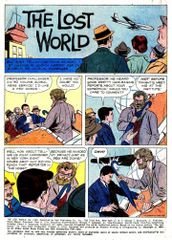
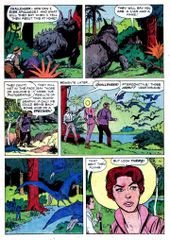


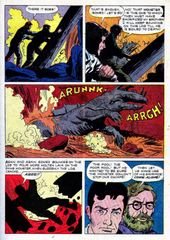

If you liked these samples you can download the whole book as a VERY LARGE pdf courtesy of Hyperdave at Datajunkie.
As for Gil Kane, he would go on to fame in the 60’s as the artist who would revitalize The Atom and Green Lantern for DC Comics, and become Marvel Comics top cover artist in the 70’s.




